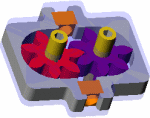 |
 |
| LUCAS-GIRLING ANTILOCK BRAKING SYSTEM | ||
| QUESTIONS OR COMMENTS | ||
 |
AUTHOR: | Courtney a. Clench |
| E-MAIL: | clench@mit.edu | |
| COURSE: | 2 | |
| CLASS/YEAR: | 2 | |
MAIN FUNCTIONAL REQUIREMENT: Prevent lockup of car braking system.
DESIGN PARAMETER: Lucas-Girling antilock braking system
GEOMETRY/STRUCTURE:
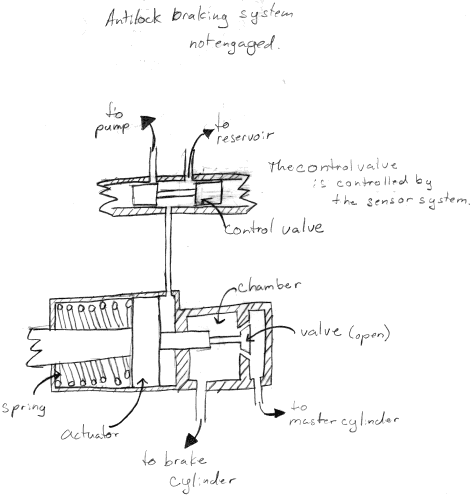 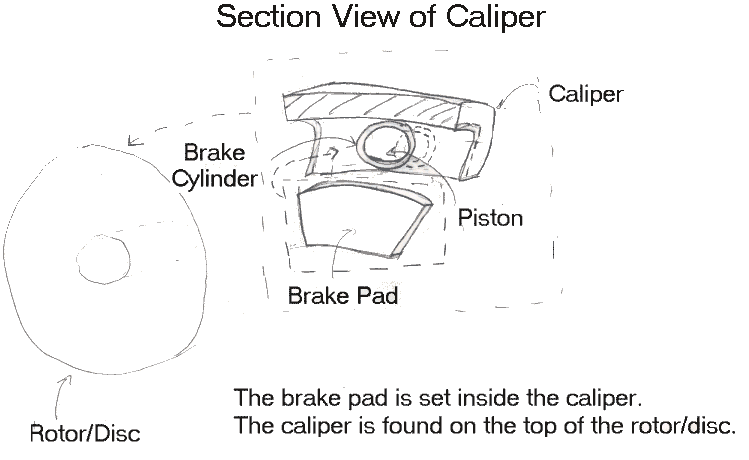 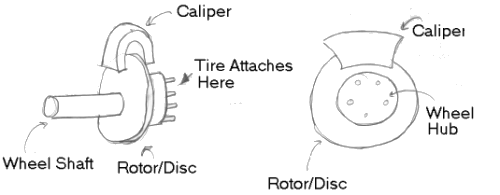 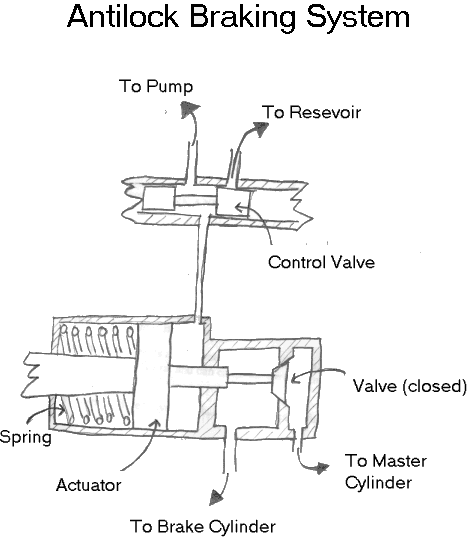 |
EXPLANATION OF HOW IT WORKS/ IS USED:
This report will explain how the Lucas-Girling antilock braking system (one of the more common systems) works on disc brakes. Antilock brake systems are designed to sense wheel locking before it occurs and then release the brakes so that locking does not occur. Locking happens when the wheels are not rotating but skidding along the road. Locking normally occurs on the rear wheels first and can cause the car to spin out. Locking can however occur on any of the wheels. There are several different systems that interact to create fully functional antilock braking system.
Hydraulic System:
Disc brakes use hydraulics to trigger braking. The hydraulic system is an enclosed
system of pipes filled with oil. When the driver presses on
the brake pedal, a piston is moved in the master cylinder. This piston increases the
pressure of the hydraulic fluid. The braking cylinders are filled with hydraulic fluid as
well, so that when the pressure in the hydraulic system is increased, the pistons move out
to contact the brake pads and engage the brakes against the rotor.
The pressure of the hydraulic fluid in the braking cylinders is proportional to the force
applied to the brake pedal by the driver.
Disc Brakes:
Disc braking systems have seven main components: the wheel shaft, the rotor/disc, the
caliper, its mounting, the brake cylinders, the pistons, and the brake pads.
 |
 |
A shaft is connected to the rotor (where the tire is attached) and transmits rotation energy from the engine to the tire. The wheel shaft and the rotor are the only components of the brakes which rotate. The remaining components are attached to the frame of the car. The caliper is connected to the car body at the mounting and contains within it the remaining components. On each of the arms of the caliper there is a brake cylinder, a piston, and a brake pad. The brake pads have frictional material on the surface to increase the friction between their surface and the rotor. The brake cylinders are recessed cylinders in the calipers themselves. The pistons sit inside the cylinders, and the brake pads lie just outside the brake cylinders. The brake pads are held so that they can freely move axially but they cannot rotate along with the rotor. The brake cylinders are filled with hydraulic fluid so that when the pressure in the hydraulic system increases, the piston is pushed out of the cylinder and the pistons will contact the brake pads. The brake pads are then forced against the rotor, and the resulting frictional force decelerates the wheel.
Sensors:
Slipping can occur between the road and the tires without the wheels actually
stopping. When this occurs the tires are decelerating rapidly. The
system recognizes this through a sensor which is an
accelerometer. When the deceleration of the wheel rises above a certain value, the
antilock brake system will engage.
Antilock Braking System:
 |
| Antilock Braking System as Engauged |
 |
| Cross section of Antilock Braking System Components/Systems |
There are many parts that make up the antilock braking system. This system takes information from the sensors and then affects the hydraulics of the brakes. When imminent locking is detected, the antilock system reacts by lessening the hydraulic pressure in the brake cylinders which disengages the brakes and prevents the wheels from locking.
The master cylinder controls the hydraulic pressure in the braking cylinder. The hydraulic system connects the master cylinder to the brake cylinder. The hydraulic fluid must pass through a valve and a chamber to get to the brake cylinder. When the brakes are engaged under normal use (the antilock braking system is not engaged), the valve is open, and the pressure in the chamber is the same as the pressure in the master cylinder.
When the sensor detects imminent locking, the control valve moves. The control valve determines the pressure in the cavity in front of the actuator by controlling what (the pump or the reservoir) is connected to the actuator. The greater pressure in front of the actuator causes it to slide back. This closes the valve between the master cylinder and the chamber. The shaft which connects the actuator to the valve has a variable cross-sectional area. As the actuator slides back, the amount of volume the hydraulic fluid can occupy in the chamber increases. This decreases the pressure of the hydraulic fluid and disengages the brakes which prevents locking.
Since locking is no longer imminent, the control valve returns to its original position. The cavity in front of the actuator is now in communication with the reservoir and not the pump, so the pressure lessens and the spring-loaded actuator returns to its original location. This opens the valve connecting the master cylinder to the braking cylinder, and normal operation of the brakes commences.
A typical antilock braking system can operate at up to 15 times a second in order to prevent the wheels from locking.
DOMINANT PHYSICS:
The energy stored in the tire and the car is usually
dissipated into heat through the frictional contact between the brake pad and the rotor.
The frictional power lost is:
Tfriction(t) * w(t) = Ploss(t) ,
where Tfriction is the frictional torque, w is the
rotational velocity of the tire, and Ploss is the power lost to heat through
friction. Since the frictional torque and the rotational velocity change with time, the
amount of power lost will also depend on time.
The integral of the power lost must equal the energy stored in the tire.
![]() ,
,
where E is the total energy to be disappated, J is the rotational inertia of the tire, mtire is the mass of the tire, v is the velocity of the car, and mcar is the mass of the rest of the car.
The frictional torque is proportional to the pressure of the hydraulic fluid.
Tfriction(t) = 2 * Ffriction(t) * R
Ffriction(t) = m * Fpad(t)
Fpad(t) = phyd(t) * Apiston
Where Ffriction is the force of friction between the brake pads and the rotor (assumes brake pad is thin radially so force acts at a certain radius), R is the radius from the center of the rotor that the brake pad is placed, m is the coefficient of friction between the brake pad and the rotor, Fpad is the force on the brake pad, phyd is the pressure of the hydraulic fluid, and Apiston is the area of the piston that the hydraulic fluid contacts. The factor of two in the equation for the frictional torque is because there are two brake pads on each rotor. All of these variables (except Apiston) are time dependent because the pressure in the hydraulic system changes with time. It depends on the force applied to the brake pedal by the driver.
If the tire is slipping with respect to the road, the same physics applies but the force on the brake pad (Fpad) no longer depends on the pressure in the hydraulic system. It is now
Fpad(t) = pchamber(t) * Apiston
where pchamber is the pressure in the chamber. This pressure is different from the pressure in the hydraulic system when the antilock braking system is engaged. When the system is not engaged, the pressure in the chamber is the same as the pressure in the hydraulic system.
LIMITING PHYSICS:
There are factors which limit the response time of the antilock braking system and factors which limit the amount of braking the disc brakes can provide. The response of the antilock braking system is governed by the response time of its components. These response times are governed by the mass of the components (and sometimes friction/damping). The mass should be kept small enough so that the response time is good, but the parts should have enough mass/substance so that the are structurally sound and are not greatly effected by the vibration of the car.
The effectiveness of the disc brakes is governed by the coefficient of friction between the brake pads and the rotor. If the coefficient of friction can be raised (by coating the surface of the brake pads with a different substance, for instance), then the effectiveness of the brakes can be increased. The hardness of the brake pads cannot exceed that of the rotor because having the brake pads coated with a very hard material will wear the rotor out excessively. The rotor is hard to replace, but the brake pads are much easier to replace and less expensive, so the brake pads should take the vast majority of the wear from the contact between them.
PLOTS/GRAPHS/TABLES:
None Submitted
WHERE TO FIND ANTILOCK BRAKES:
Antilock brakes can be found in most modern automobiles.
REFERENCES/MORE INFORMATION:
Newton, Steeds, and Garrett. (1996). The Motor Vehicle. Oxford, England. Butterworth-Heinemann Press.